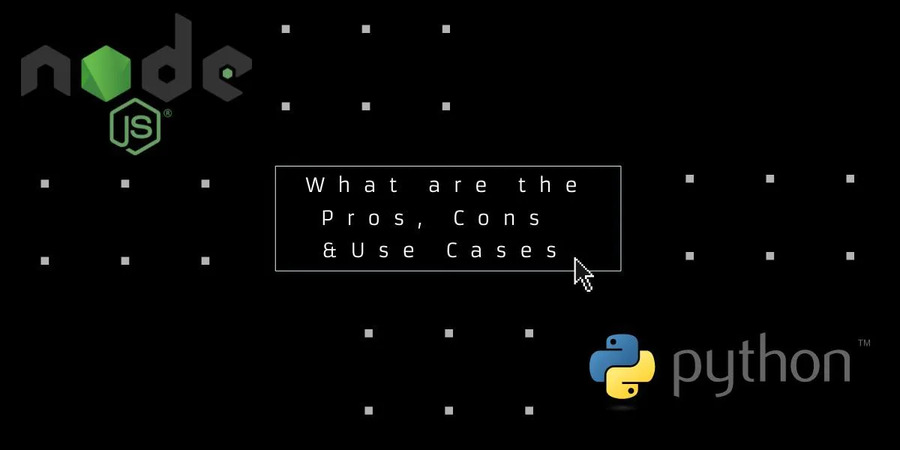When choosing a programming language for Backend development, your choice will determine how the product will perform, scale, and meet user needs.
| Join the channel Telegram of the AnonyViet 👉 Link 👈 |

One of the most awkward choices is Node.js vs Python. These two languages are very popular and have their own pros and cons. So in this article, we will compare their advantages and disadvantages and help you decide which language is better for your project.
Deciding factors when choosing a programming language
Before choosing a programming language, determine your requirements first. Focus on the following points:
- Define product type. Is it a data-intensive application or an interface-focused program? Is its functionality mostly static or interactive? At this stage, analyze your competition, market, and end-user needs.
- Define the area. You must understand where your product will be used: in a particular region, nationally or internationally. The larger the area, the more carefully you have to think about architectural and technological solutions.
- Conduct marketing research. It’s important to be unique and get constant attention. It means doing marketing research, understanding your main competitors and the personality of your users.
- Analyze your resources. How many people do you have with the right experience and whether you need to hire more developers.
- Clarify key performance criteria. There is no perfect backend development tool. Analyze speed, security, interactivity, responsiveness, and pick the ones you prioritize the most.
Python
Python is a dynamic, object-oriented language that is prized for its simple syntax and universality. Python is still one of the most employed languages on the market. One of its main advantages is its support for multiple programming styles, making it well-suited for complex computational projects and simple websites.
Statista defines Python as the most popular programming language in 2020. It is used by 29% of developers worldwide. According to research by JetBrains, 87% of developers know Python and use it as their primary programming language. 27% of them use Python in web development, 28% – in machine learning (machine learning) and 18% – in data analytics.
Python grants access to the Berkeley sockets API. This is the client-server network handling module. Python provides a simple and rigorous API that corresponds to the C equivalent system calls. Python has classes that make it easier to use these low-level socket methods.
Advantages of Python
Rapid deployment and development
The dynamic and object-oriented syntax allows Python developers to spend less time working on complex pieces of code. Many packages, add-ons, and libraries provide ready-to-go options from the simplest web backend software to complex scientific calculations.
These make Python a perfect decision for the development of MVPs and prototypes. As a result, companies can get to market faster, and code reuse rates are high.
Simple syntax
Python uses fewer lines of code than other languages and frameworks. It’s not just about volume, it’s also about making your code easier to understand when working as a team. Python allows programmers to express complex ideas in a few lines of code.
Python has the particular advantage of frequently using English terms rather than mathematical expressions. The code is easy to read and understand.
Vast ecosystem
Python meets many development challenges. While the ecosystem isn’t new, the constant addition of new packages and add-ons keeps it up to date with technology. Currently, python is one of the most suitable languages for AI, computer vision, machine learning, data science, statistics and other fields.
Important community
Python has been around for a while, so it has built a large community. Developers use open source resources and tutorials, making it easier to develop skills and exchange experiences.
This community may not seem important at first, but it helps developers Q&A and updates.
Disadvantages of Python
Speed
Python won’t be the best choice if you prioritize speed. Python easily handles intensive operations, but takes more time than other languages. If you need to run a lot of tasks, Node.js will suit you better with asynchronous input and output.
Mobile performance
Low performance in mobile apps is a big problem. If the backend is slow by design, the user experience will suffer. Another problem with adapting Python code for mobile is that it doesn’t work well with native components. If you add effects from an incompatible codebase with low performance, you will have performance problems.
Node.js
Node.js is a runtime environment for backend development based on the JavaScript programming language.
Node.js uses asynchronous, event-driven input-output. It turns out that the runtime environment can handle several requests at the same time without having to wait for the previous request to complete.
Node.js is the most used framework, according to Statista. About 53% of all developers use Node.js for their projects. Twitter, Aliexpress, Coursera and many other huge services are created with Node.js. Netflix and Paypal have chosen Node.js to empower their microservices. It allowed them to shorten the boot time from 40 minutes to just 1 minute.
Node.js is a programming language that allows you to create WebSocket (a protocol that allows creating a real-time bidirectional client-server network). In online applications, WebSockets are an alternative to HTTP communication. The channel is kept open when a connection is established, allowing for fast, low-latency and low-cost connections to client-server networks. Chat, online multiplayer, Google Docs, and other common use cases are just a few examples.
The main advantage of Node.js is the way it handles complex concurrent processes. Large companies choose it to power their infrastructure because of its ability to handle large workloads quickly.
Advantages of Node.js
Fast performance
The main reason to use Node.js is because it has super fast performance. It handles multiple requests in parallel on a single Node.js server.
Node.js uses Google Chrome’s V8 engine as the runtime environment to execute JavaScript. This tool uses just-in-time compilation to process JavaScript code and provide instant output quickly. It makes Node.js a good choice for interactive development.
As a result, you get a great user experience, making Node.js the top choice for real-time apps, messaging apps, games, and more.
Full stack web development
Full-stack web development is trending – businesses like Medium, Airbnb, Paypal, Netflix have turned to Node.js to use JavaScript both on the front end and backend development. It guarantees:
- Better teamwork. Work with a single team instead of 2 separate front end and backend teams.
- Code reuse. Developers are free to reuse the code from the front end for backend development and vice versa. It reduces the number of lines of code, impacts delivery speed, and makes refactoring and maintenance simpler.
- A large talent pool. One of the most widely used programming languages is JavaScript. A skilled front-end engineer can easily learn Node.js because the fundamentals are very similar. So becoming a Full-stack web developer will be easier.
Reusing JavaScript throughout development on a Node.js server speeds up delivery and makes communication easier. It’s a huge advantage when all team members can understand the code.
Microservices development
The Node.js server has many NPM packages. Netflix and Paypal have simultaneously migrated to Node.js and microservices, which has yielded amazing results. They removed duplicate code, organized the architecture, introduced additional functionality, and improved the user experience.
Disadvantages of Node.js
Low performance with big data
At larger data volumes, Node.js is not well equipped to handle complex operations. Its advantage is fast processing of many simple requests, but anything complicated leads to delays.
- A single thread event loop. When talking about fast I/O operations, the tasks will finish quickly. But if it’s a calculation, it takes a while to get the results. The upstream stream is blocked and other operations cannot be performed.
- Node.js and JavaScript. JavaScript is a user interface language that complements Node.js’ limited CPU capabilities. It does not communicate smoothly with the hardware and processing unit.
Suppose your application has to run complex operations. Node.js is not a good choice. There are ways to make Node.js work better with complex tasks, but the default functions don’t work well.
Messy syntax
This programming language is built on top of the NPM module, allowing you to extend the built-in functionality and create almost anything. However, a particular module may work fine on its own but not be compatible with the rest of the system.
Some NPM modules may be incompatible and need to be reset. If you run large infrastructure, this error can lead to several problems.
Python use cases
- Data Science: work with data collection and analysis. Apache Spark, the Facebook data analytics system, and the speech recognition system use Python as the primary programming language.
- Complex web platform: perform calculations, process lots of data, and analyze.
- 2D and 3D GUI: Python APIs like Scribus, Maya, and Blender are great for creating complex animations and graphics.
- Technical sorfware: FreeCAD, an application for 3D modeling, analysis software like Abaqus and others built on Python.
- Data collection and parsing software: Collect data for forecasts and analysis and display the results in a visual dashboard.
- Testing and development: write test automation frameworks.
Node.js . use cases
- Streaming Apps: create an uninterrupted streaming environment.
- Collaboration platform: when several users join an audio or video conference or edit files simultaneously, Node.js ensures real-time updates. Trello is a prime example.
- Real-time messaging: Many APIs and NPMs allow two-way exchanges to be created over a single connection, which is what messaging applications need. It also has add-ons for real-time server-side notifications and updates.
Conclusion
Node.js and Python are great backend languages that offer impressive capabilities to developers. Python is great at performing complex operations and supports extensions, but it lags behind in speed. Node.js has outstanding performance but is not good at handling complex operations. The final decision depends on your project type.









